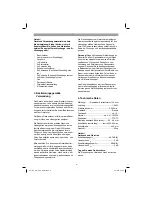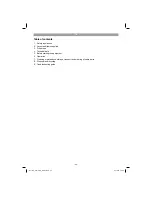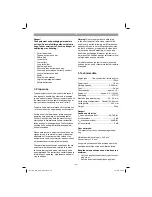
GB
- 23 -
•
Adapt your working style to suit the appliance.
•
Do not overload the appliance.
•
Have the appliance serviced whenever ne-
cessary.
•
Switch the appliance off when it is not in use.
Caution!
Residual risks
Even if you use this electric power tool in
accordance with instructions, certain resi-
dual risks cannot be rules out. The following
hazards may arise in connection with the
equipment’s construction and layout:
1. Damage to hearing if no suitable ear protec-
tion is used.
2. Health damage caused by hand-arm vib-
rations if the equipment is used over a pro-
longed period or is not properly guided and
maintained.
5. Before starting the equipment
5.1 Assembling the components
Some parts of the equipment come disassem-
bled. For quick and easy assembly, read and
follow the instructions below.
Note! You will need the following additional tools
(not supplied) for assembly, and also for mainte-
nance work:
•
One flat oil drip tray (for changing the oil)
•
One 1 liter measuring jug (oil/petrol resistant)
•
One petrol can
•
One funnel (suitable for the tank’s petrol filler
neck)
•
Household wipes (to wipe up oil/petrol resi-
due; dispose of these at a filling station)
•
One petrol suction pump (plastic, available
from DIY stores)
•
One oil can with hand pump (available from
DIY stores)
•
Engine oil
Assembly
1. Fit the lower and upper push bar (Item. 3) as
shown in Fig. 3a-3b. For fastening choose
one of the holes to suit the required height of
the push bar.
Important! The identical height must be set on
both sides.
2. Insert the grip of the starter cable (Item 9) into
the hook provided for that purpose as shown
in Fig. 3c.
3. Fasten the actuator cables to the push bar
with the supplied cable clips (Item 10) as
shown in Fig. 3d.
4. Lift the ejector
fl
ap (Item 5a) with one hand
and hook in the grass bag (Item 4a) as shown
in Fig. 4a.
5.2. Adjusting the cutting height
Warning! Adjust the cutting height only when
the engine has been switched o
ff
.
•
The cutting height is centrally adjusted with
the cutting height adjustor lever (Fig. 7/Item
8). Different cutting heights can be selected.
•
Actuate the adjustor lever and pull it to the
required position. Let the lever click into po-
sition.
6. Operation
Note!
The engine comes without oil and petrol.
Therefore, be sure to add oil and petrol befo-
re starting the engine.
1. Check the oil level (see 7.2.1).
2. Use a funnel and measuring jug to
fi
ll the tank
with petrol. Make sure that the petrol is clean.
Warning:
Never use more than one safety petrol
can. Do not smoke when refueling. Switch o
ff
the
engine before refueling and allow the engine to
cool down for a few minutes.
3. Ensure that the ignition cable is connected to
the spark plug.
Carrying out a safety test on the engine start/
stop lever
The lawn mower comes equipped with an engi-
ne start/stop lever (Fig. 5a/Item 1a) in order to
prevent it from starting up unintentionally and to
ensure that the engine and blade stop quickly in
case of danger. The lever must be actuated (Fig.
5b) before the lawn mower is started. When the
engine start/stop lever is released, it must return
to its initial position (Fig. 5a).
Before you start mowing, you should run through
this process several times in order to ensure that
the lever and actuator cables are working pro-
perly.
Anl_GC_PM_46_S_SPK7.indb 23
Anl_GC_PM_46_S_SPK7.indb 23
31.10.14 12:24
31.10.14 12:24
















































